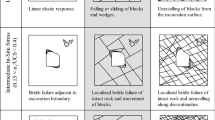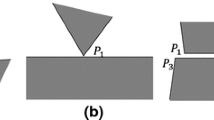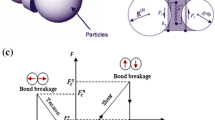Abstract
Understanding the time-dependent deformation behavior of rock joint is important when evaluating long-term stability of structures built on or in jointed rock masses. This study focuses on the time-dependent strength and deformation of unweathered clean rock joints. First, five grain-scale joint models are established based on Barton’s standard joint profiles using the GBM-TtoF creep material model. Barton’s non-linear shear strength criterion is adopted to determine the short-term shear strength of the joints. Second, a series of creep simulations are conducted to investigate major factors (normal stress, shear loading ratio, and joint roughness) that influence the long-term shear strength and the sliding velocity of the joints. The results reveal that normal stress has more influence than joint roughness on resisting creep slipping of the joints. Third, an equation for the prediction of creep sliding velocity is developed by fitting the simulation results and the equation is verified by experimental data. Finally, a creep slipping model for simplified flat joints is proposed, which can be used to model the long-term shear strength and sliding velocity of joints under creep deformation conditions. The creep slipping model, which can be used in both stationary and variable stress conditions, is useful for simulating time-dependent behaviors of jointed rock mass using the distinct element method.





















Similar content being viewed by others
Abbreviations
- \(\tau_{S}\) :
-
Short-term shear strength
- \(\tau_{L}\) :
-
Long-term shear strength
- JCS :
-
Joint wall compressive strength
- \(\phi_{b}\) :
-
Basic friction angle of macro-joint
- JRC :
-
Joint roughness coefficient
- \(\sigma_{n}\) :
-
Normal stress
- UCS :
-
Uniaxial compressive strength of rock
- \(c\) :
-
Cohesion of rock in the TtoF (time-to-failure) model
- \(\phi\) :
-
Friction angle of rock in the TtoF model
- \(\sigma_{t}\) :
-
Tensile strength of rock in the TtoF model
- \(c^{c}\) :
-
Cohesion of contact element
- \(\phi^{c}\) :
-
Friction angle of contact element
- \(\sigma_{t}^{c}\) :
-
Tensile strength of contact element
- \(i\) :
-
Dilation angle of contact element
- \(Jks\) :
-
Shear stiffness of contact element
- \(Jkn\) :
-
Normal stiffness of contact element
- \({\tau \mathord{\left/ {\vphantom {\tau {\tau_{S} }}} \right. \kern-\nulldelimiterspace} {\tau_{S} }}\) :
-
Shear loading ratio
- \(\xi\) :
-
Long-term shear strength ratio
- \(JRC_{mob}\) :
-
Mobilized joint roughness
- \(\phi_{mob}\) :
-
Mobilized joint friction angle
- \(JRC_{c - mob}\) :
-
Mobilized joint roughness due to creep damage
- \(C_{j}\) :
-
Dimensionless parameter
- \(\xi_{0}\) :
-
Basic long-term shear strength ratio
References
Alejano LR, González J, Muralha J (2012) Comparison of different techniques of tilt testing and basic friction angle variability assessment. Rock Mech Rock Eng 45:1023–1035
Bahaaddini M, Hagan P, Mitra R, Khosravi M (2016) Experimental and numerical study of asperity degradation in the direct shear test. Eng Geol 204:41–52
Bandis S, Lumsden A, Barton N (1981) Experimental studies of scale effects on the shear behaviour of rock joints. In: Int J Rock Mech Mining Sci Geomech Abstr, 1981. vol 1. Elsevier, pp 1–21
Barton N (1995) The influence of joint properties in modelling jointed rock masses. In: 8th ISRM Congress, 1995. International Society for Rock Mechanics and Rock Engineering
Barton N, Choubey V (1977) The shear strength of rock joints in theory and practice. Rock Mech 10:1–54
Barton N, Bandis S, Bakhtar K (1985) Strength, deformation and conductivity coupling of rock joints. In: Int J Rock Mech Mining Sci Geomech Abstr, 1985. vol 3. Elsevier, pp 121–140
Bhasin R, Høeg K (1998) Parametric study for a large cavern in jointed rock using a distinct element model (UDEC-BB). Int J Rock Mech Min Sci 35:17–29
Bieniawski Z (1976) Rock mass classification in rock engineering applications. In: Proceedings of a Symposium on Exploration for Rock Engineering, 1976, 1976. pp 97–106
Bieniawski ZT (1989) Engineering rock mass classifications: a complete manual for engineers and geologists in mining, civil, and petroleum engineering. Wiley, Hoboken
Boon CW (2013) Distinct element modelling of jointed rock masses: algorithms and their verification., Oxford University, UK
Bowden RK, Curran J (1984) Time-dependent behaviour of joints in Shale. In: The 25th US Symposium on Rock Mechanics (USRMS), 1984. American Rock Mechanics Association
Chen WZ, Zhu WS, Shao JF (2004) Damage coupled time-dependent model of a jointed rock mass and application to large underground cavern excavation. Int J Rock Mech Min Sci 4:669–677
Chigira M (1992) Long-term gravitational deformation of rocks by mass rock creep. Eng Geol 32:157–184
Cristescu N, Fotǎ D, Medveş E (1987) Tunnel support analysis incorporating rock creep. In: Int J Rock Mech Mining Sci Geomech Abstr, 1987. vol 6. Elsevier, pp 321–330
Feng J, Chuhan Z, Gang W, Guanglun W (2003) Creep modeling in excavation analysis of a high rock slope. J Geotech Geoenviron Eng 129:849–857
Gadi AM (1986) Creep along a discontinuity in granite.
Glamheden R, Hoekmark H (2010) Creep in jointed rock masses. State of knowledge. Swedish Nuclear Fuel and Waste Management Co
Goodman RE (1989) Introduction to rock mechanics, vol 2. Wiley, New York
He ZL, Zhu ZD, Ni XH, Zj Li (2019) Shear creep tests and creep constitutive model of marble with structural plane. Eur J Environ Civil Eng 23:1275–1293
Itasca (2015) UDEC, Universal distinct element code., 6.0 edn. Itasca Consulting Group. Inc, Minneapolis
Kemeny J (2003) The time-dependent reduction of sliding cohesion due to rock bridges along discontinuities: a fracture mechanics approach. Rock Mech Rock Eng 36:27–38. https://doi.org/10.1007/s00603-002-0032-2
Lajtai E (1991) Time-dependent behaviour of the rock mass. Geotech Geol Eng 9:109–124
Lajtai E, Gadi A (1989) Friction on a granite to granite interface. Rock Mech Rock Eng 22:25–49
Liu G, Cai M (2020) Modeling time-dependent deformation behavior of brittle rock using grain-based stress corrosion method. Comput Geotech 118:103323
Liu J, Feng XT, Ding XL, Zhou HM In situ tests on creep behavior of rock mass with joint or shearing zone in foundation of large-scale hydroelectric projects. In: Key Engineering Materials, 2004. Trans Tech Publ, pp 1097–1102
Liu A, Lin WL, Jiang JC (2019) Investigation of the long-term strength properties of a discontinuity by shear relaxation tests. Rock Mechanics and Rock Engineering, pp 1–10
Malan D (1998) An investigation into the identification and modeling of time-dependent behaviour of deep level excavations in hard rock [Ph. D. Thesis]. South Africa: University of Witwatersrand
Martín LB, Rutqvist J, Birkholzer JT (2015) Long-term modeling of the thermal–hydraulic–mechanical response of a generic salt repository for heat-generating nuclear waste. Eng Geol 193:198–211
Potyondy DO (2007) Simulating stress corrosion with a bonded-particle model for rock. Int J Rock Mech Mining Sci 44:677–691
Schmidtke RH, Lajtai E The long-term strength of Lac du Bonnet granite. In: Int J Rock Mech Mining Sci Geomech Abstr, 1985. vol 6. Elsevier, pp 461–465
Shen MR, Zhang QZ (2010) Study of shear creep characteristics of greenschist discontinuities. Chin J Rock Mech Eng 29:1149–1155
Shrader-Frechette KS (1993) Burying uncertainty: Risk and the case against geological disposal of nuclear waste. Univ of California Press,
Tang ZC, Wong LNY (2016) Influences of normal loading rate and shear velocity on the shear behavior of artificial rock joints. Rock Mech Rock Eng 49:2165–2172
Tatone BSA (2014) Investigating the evolution of rock discontinuity asperity degradation and void space morphology under direct shear. University of Toronto, Canada
Wang MZ, Cai M (2020) A grain-based time-to-failure creep model for brittle rocks. Comput Geotech. https://doi.org/10.1016/j.compgeo.2019.103344
Wang JA, Wang YX, Cao QJ, Ju Y, Mao LT (2015) Behavior of microcontacts in rock joints under direct shear creep loading. Int J Rock Mech Min Sci 78:217–229
Wang Z, Shen MR, Ding WQ, Jang B, Zhang QZ (2017a) Time-dependent behavior of rough discontinuities under shearing conditions. J Geophys Eng 15:51–61
Wang Z, Shen MR, Tian GH, Zhang QZ (2017b) Time-dependent strength of rock mass discontinuity with different values of JRC. Chin J Rock Mechan Eng 31:10. https://doi.org/10.13722/j.cnki.jrme.2016.0018
Wasantha P, Ranjith P, Zhang Q, Xu T (2015) Do joint geometrical properties influence the fracturing behaviour of jointed rock? An investigation through joint orientation. Geomech Geophys Geo-Energy Geo-Resour 1:3–14
Xu WY, Yang SQ (2005) Experiment and modeling investigation on shear rheological property of joint rock. Chin J Rock Mechan Eng 24:5536–5542
Xu T, Xu Q, Tang CA, Ranjith P (2013) The evolution of rock failure with discontinuities due to shear creep. Acta Geotech 8:567–581
Xue YT, Mishra B Numerical Study on the Time-Dependent Behavior of Rock Joints. In: 53rd US Rock Mechanics/Geomechanics Symposium, 2019. American Rock Mechanics Association
Yang SQ, Xu WY, Yang SL (2007) Investigation on shear rheological mechanical properties of shale in Longtan Hydropower Project. Yantu Lixue (Rock and Soil Mechanics) 28:895–902
Yang B, Mo S, Wu P, He C (2013) An empirical constitutive correlation for regular jugged discontinuity of rock surfaces. Adv Appl Math Mech 5:258–268
Zhang X-P, Wong LNY (2013) Crack initiation, propagation and coalescence in rock-like material containing two flaws: a numerical study based on bonded-particle model approach. Rock Mech Rock Eng 46:1001–1021
Zhang Q, Shen M, Ding W (2012) Study of shear creep constitutive model of greenschist structural plane. Rock Soil Mech 33:7. https://doi.org/10.16285/j.rsm.2012.12.009
Zhang QZ, Shen MR, Ding WQ (2015) The shear creep characteristics of a green schist weak structural marble surface. Mech Adv Mater Struct 22:697–704
Zhang QZ, Shen MR, Jang BA, Ding WQ (2016) Creep behavior of rocks with rough surfaces. J Mater Civ Eng 28:04016063
Zhang QZ, Wu CZ, Fei XC, Jang BA, Liu DQ (2019) Time-dependent behavior of rock joints considering asperity degradation. J Struct Geol 121:1–9
Acknowledgements
This work was financially supported by NSERC (Natural Science and Engineering Research Council of Canada, RGPIN-2016-04052), the China Scholarship Council (Grant No. CSC201806370225), and MIRARCO of Laurentian University.
Author information
Authors and Affiliations
Corresponding author
Ethics declarations
Conflict of interest
The authors wish to confirm that there are no known conflicts of interest associated with this publication and there has been no significant financial support for this work that could have influenced its outcome.
Additional information
Publisher's Note
Springer Nature remains neutral with regard to jurisdictional claims in published maps and institutional affiliations.
Rights and permissions
About this article
Cite this article
Wang, M., Cai, M. A Simplified Model for Time-Dependent Deformation of Rock Joints. Rock Mech Rock Eng 54, 1779–1797 (2021). https://doi.org/10.1007/s00603-020-02346-2
Received:
Accepted:
Published:
Issue Date:
DOI: https://doi.org/10.1007/s00603-020-02346-2




